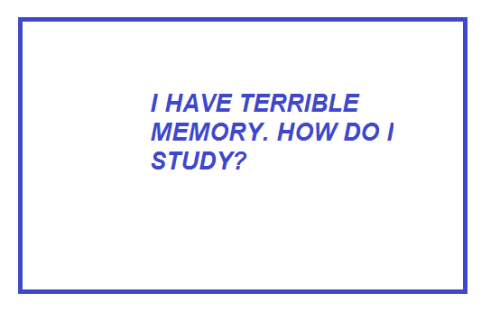What I Think Is Really Interesting About The Papyrus Account Of The Workers Building The Tomb Of Rameses
What I think is really interesting about the papyrus account of the workers building the tomb of Rameses III going on strike to demand better wages is really fascinating to me because if you look at the description given by the royal scribe you see that there was an attempt to satisfy the workers by bringing a large amount of food at once but that was rebuffed by the workers who declared that it wasn’t just that they were hungry at the moment but had serious charges to bring that “something bad had been done in this place of Pharoah” (is poor wages and mistreatment). They understood themselves as having long term economic interests as a -class- and organized together knowing that by doing so they could put forward their demands collectively. It so strongly flies in the face of narratives that are like “in this Time and Place people were happy to be serve because they believed in the God-King and maybe you get some intellectual outliers but certainly no common person questioned that”. If historical sources might paint that sorta picture of cultural homogeneity it is because those sources sought not to describe something true but invent a myth for the stability of a regime.
More Posts from Swirlspill-study and Others

HOW TO WRITE A HIGH-GRADE RESEARCH PAPER
~~~~~~~~~~~~~~~~~~~~~~~~~~~~~~~~~~~~~~~~~~
The first time I had to write a research paper for university was one of the most stressful experiences I’d ever had - it was so different to anything I’d ever done before and caused me so much anxiety! It turned out that I’m pretty damn good at writing research reports and I’m now looking to pursue a career in psychological research.
I have never received less than a First (or 4.0 GPA for you American studiers) in my research papers so I thought I’d share my top tips on how to write a kick-ass, high-grade research paper.
*disclaimer: I am a psychology student, my tips are based on my personal experience of writing up psychological research (quantitative and qualitative); therefore, they may require some adaptation in order to be applied to your field of study/research*
These tips will be split up into the different sections a research paper should consist of: abstract, introduction, methods, results, discussion, references and formatting.
ABSTRACT
The aim of an abstract is to summarise your whole paper - it should be concise, include key-words, highlight the key points of your paper and be written last.
When I say concise, I mean concise! The abstract is what other students and researchers will read in order to decide whether your research is relevant their own work and essentially determines whether or not they’ll read on - they want to know the key details and don’t want to be overwhelmed with information.
I always aim to keep my abstracts under 250 words. I set myself this limit to stop myself waffling and dwelling on unimportant points, it helps me to be really selective of what I include and ensures I’m gripping the reader from the start.
Your abstract should discuss the research rationale, the methods and designs used, your results and the general conclusion(s) drawn. One or two sentences on each of these topics is enough.
Make sure you’re using key-words throughout your abstract as this will also help the reader decide whether your work is relevant to theirs. You can make key-words super obvious by highlighting them in a key at the bottom of your abstract (see below) or just used jargon consistently. Using key-words is also important if you’re looking to get your work published, these words will help people find your work using search engines.

Finally, write your abstract last! An abstract is a summary of your whole research paper which makes it practically impossible to write well first. After writing the rest of your paper, you will know your research inside and out and already have an idea of what key things you need to highlight in your abstract.
INTRODUCTION
For me, the introduction section is always the most intimidating to write because it’s like painting on a blank canvas - massively daunting and leaving you terrified to make a mistake!
The aim of an introduction is to provide the rationale for your research and justify why your work is essential in the field. In general, your introduction should start very broad and narrow down until you arrive at the niche that is your research question or hypothesis.
To start, you need to provide the reader with some background information and context. You should discuss the general principle of your paper and include some key pieces of research (or theoretical frameworks if relevant) that helps your reader get up to speed with the research field and where understanding currently lies. This section can be pretty lengthy, especially in psychological research, so make sure all of the information you’re including is vital as it can be pretty easy to get carried away.
This background should lead you onto the rationale. If you’ve never written a research paper before, the rationale is essentially the reason behind your own research. This could be building on previous findings so our understanding remains up to date, it could be picking up on weaknesses of other research and rectifying these issues or it could be delving into an unexplored aspect of the field! You should clearly state your rationale and this helps lead into the next section.
You should end your introduction by briefly discussing your current research. You need to state your research question or hypothesis, how you plan on investigating the question/hypothesis, the sample you plan on using and the analysis you plan to carry out. You should also mention any limitations you anticipate to crop up so you can address these in your discussion.
In psychology, references are huge in research introductions so it is important to use an accurate (and modern as possible) reference for each statement you are making. You can then use these same references in your discussion to show where your research fits into the current understanding of the topic!
METHODS
Your methods section should make use of subheadings and tables where necessary and should be written in past tense. This can make the (potentially) lengthy section easier to navigate for the reader. I usually use the following headings: participants, materials, design, procedure.
The participants section should describe the sample that took part in your research. Age, gender, nationality and other relevant demographic information should be provided as well as the sampling technique. Personally, I use a table (see below) alongside my continuous prose as an alternative way of viewing my sample population. Please note, if you’re using a table make sure it adheres to your university guidelines.

The materials section of your methods should include any equipment, resources (i.e. images, books, diagrams) or any other materials used in your data collection. You should also reference the program that helped you conduct your analysis. For example, if you are writing a qualitative research paper, you may want to include Microsoft Word in your materials if you use the program to transcribe interviews.
You should then describe the design used in your research. All variables should be identified in this paragraph, if relevant. You should also discuss whether your research is within-groups or between-groups, again only if relevant.
Last is your procedure section - the most important one! You must write this section with enough detail so that anybody could pick it up, read it and conduct the same experiment with ease. You should describe what participants were required to do, how data was collected and it should be written in chronological order! While it’s important to provide enough information, try not to overwhelm the reader with lengthy sentences and unnecessary information.
RESULTS
Your results section’s sole purpose is to provide the reader with the data from your study. It should be the second shortest section (abstract being first) in your research paper and should stick to the relevant guidelines in regards to reporting figures, tables and diagrams. Your goal is to relay results in the most objective and concise way possible.
Your results section serves to act as evidence for the claims you’ll go on to make during your discussion but you must not be biased in the results you report. You should report enough data to sufficiently justify your conclusions but must also include data that doesn’t support your original hypothesis or research question.
Reporting data is most easily done through tables and figures as they’re easy to look at and select relevant information. If you’re using tables and figures you should always make sure you’re stating effect sizes and p values and to a consistent decimal place. Illustrative tables and figures should always be followed by supporting summary text consisting of a couple of sentences relaying the key statistical findings in continuous prose.
DISCUSSION
The discussion section should take the opposite approach to your introduction! You should start discussing your own research and broaden the discussion until you’re talking about the general research field.
You should start by stating the major findings of your study and relating them back to your hypothesis or research questions. You must must must explicitly state whether you reject or accept your experimental hypothesis, if you have one. After stating your key findings you should explain the meaning, why they’re important and where they fit into the existing literature. It’s here that you should bring back the research you discussed in your introduction, you should relate your findings to the current understanding and state the new insight your research provides.
You should then state the clinical relevance of your research. Think about how your findings could be applied to real-life situations and discuss one or two practical applications.
After this, discuss the limitations of your research. Limitations could include sample size and general sample population and how this effects generalisability of findings, it could include methodological problems or research bias! These limitations will allow you to discuss how further research should be conducted. Suggest ways in which these limitations could be rectified in future research and also discuss the implications this could have on findings and conclusions drawn.
Finally, you need to give the reader a take-home message. A sentence or two to justify (again) the need for your research and how it contributes to current understanding in the field. This is the last thing your audience will read so make it punchy!
~~~~~~~~~~~~~~~~~~~~~~~~~~~~~~~~~~~~
That’s it folks! My tips for writing a kick-ass, high-grade research paper based on my personal experience. If you have any questions regarding things I’ve missed or didn’t provide enough detail of, then please just send me an ask!
Also, if any of you would like to read any of my past research papers I would be more than happy to provide you with them :-))
random things I do to fool my brain into staying interested during online study
changing my chrome cursor into something cute like a strawberry
changing my chrome theme to a wacky colour
adding stickers onto my laptop
listening to new music in a language I don’t know
or hyped video game music for energy
buying a fidget toy. like deadass I had my doubts but they’re so good
using the web paint extension while in meetings or lectures
changing the appearance of whatever note taking app you use
for epic gamers with light-up keyboards, changing the light’s colour settings
having a very hot or very cold drink
putting said drink directly under my face when working and using a straw, so I don’t forget it’s there and don’t have to move my head much to sip
hav u eaten or drank anything today hey hello it’s already midday
sparkling water perchance?? it’s water but it’s fun and interesting
ambient fireplace 10 hours loop
alternatively, death metal hardcore bass boosted.mp3
putting on a ridiculous outfit and pretending you’re a wizard doing important work. I have given up on being “put together” at this stage
getting up and having scheduled dance breaks to move around
don’t like your chair? are u gay and can’t sit normal? try arranging pillows and boxes to make a diy cross-legged chair or sit on the floor
u kno when you get a million ideas during studying but u don’t want to break focus: hey siri okay google alexa remind me in a sec about this very specific thing that just couldn’t wait 10 more minutes to force itself into brain
giving up. lmao sometimes you genuinely need a break and nothing you do will make your brain focus so don’t feel guilty for needing rest! it’s technically more productive to spend the time resting and recharging than forcing yourself to half assedly focus and get nothing done
tl;dr- changing appearances of devices often for Spice, having small snacks and various drinks, hype music for energy, any and all fidget toys, knowing when to give up
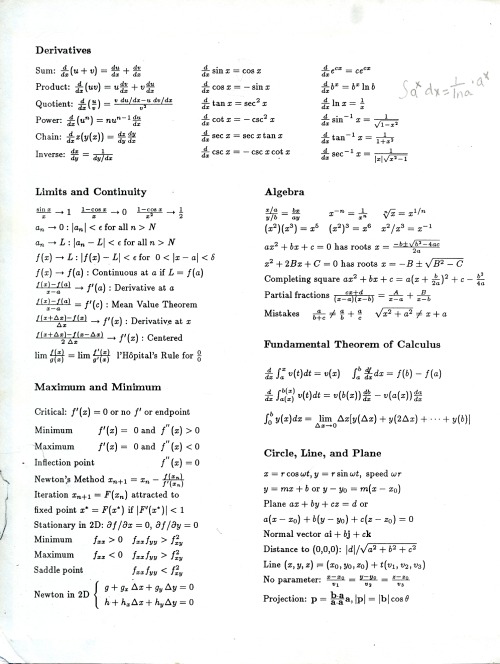
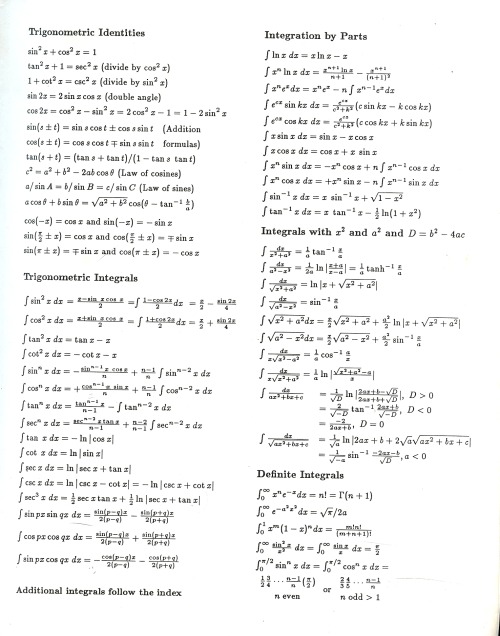
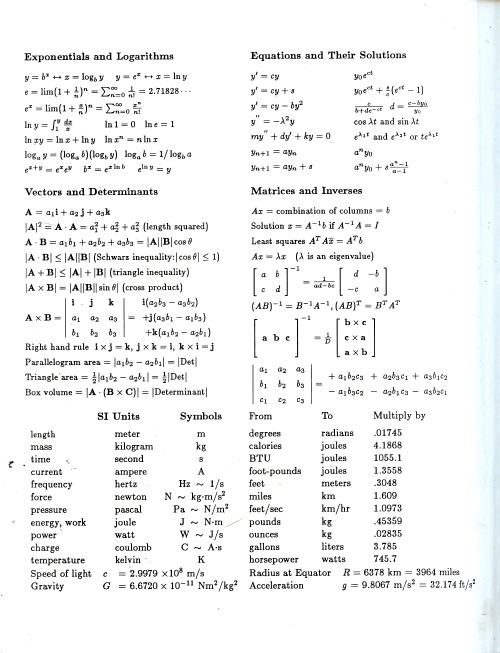
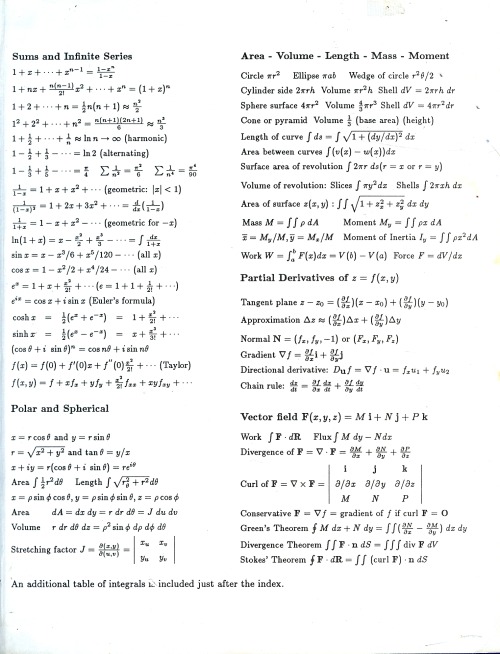
Scans of the inside covers of Strang’s Calculus, which you can legally-download for free here from the MIT website. This is my all-time favorite math or physics textbook. Scanned it so I could cut and paste it into my new sketchbook, wanna try and make a ~cool artistic~ reference poster out of it, ‘cuz I’ve been real into that idea since I took notes about rings for the algebra midterm on a big piece of watercolor paper.
Introduction to LaTeX!
No, not the rubbery plasticy stuff
LaTeX (pronounced “lay-tech”) is a free document-formatting system commonly used in STEM fields. This post is going to explain why it is really useful and where you can start!
So if you’re a STEM student, you’ve probably had to write a whole lot of lab reports and know how annoying it is to either figure out Word’s equation editor or screenshot a picture of whatever equation you’re trying to include in your report. Not to mention how awful Word is at formatting pictures, holding them in place and keeping things consistent. LaTeX solves most of those problems for you.
It works with some simple commands and packages that allow you to create journal-style articles, lab reports, and all sorts of other document types. You can include all sorts of mathematical and scientific symbols and equations and LaTeX formats them correctly for you. It might seem daunting at first, but most of the commands are very intuitive and you have a lot of easy customisation and consistent formatting. It can even do referencing for you. It has a lot of other cool things like generating a table of contents, automatically numbering your tables and figures, that contribute to producing a professional-looking scientific document.
All in all, the learning curve is very shallow, and the skill payoff is worth the small time investment it takes to learn. LaTeX typesetting is a very valuable skill to have in STEM.
Where to start:
There are dozens of downloadable LaTeX text editors, but I prefer to use an online one called Overleaf. It has several templates available for you to start from, provides shareable links, renders your document as you work, and, because it’s online, you can upload all your files to the server and work from anywhere.
I found the first chapter of this guice very helpful when I began using LaTeX [x].
Some random tips I picked up so far:
1) Most problems/errors are easy to solve with a quick google search. Because LaTeX is so widely used, there are a LOT of stack exchange solutions to small problems.
2) Manually creating LaTeX tables is a nightmare. It’s usually easiest to make them first in Excel, then copy-and-paste into an online LaTeX table generator.
3) Lots of journal articles have a pre-formatted bibtex citation linked somewhere. Using that citation works really well.
4) I like to open a text file, copy-and-paste all my bibtex formatted citations into it and convert it into a .bib file by renaming.
Some other useful links:
~LaTeX table generator [x]
~LaTeX reference generator [x]
~Find the LaTeX command for any symbol that you draw [x]
~List of mathematical symbols for LaTeX [x]
~LaTeX Stack Exchange [x]
I hope you find this helpful! If you have any questions, don’t hesitate to send me an ask or a message. Check out my study instagram if you’re keen on seeing some of my studyspo. Happy studying!
xx Munira




august 23, 2016 | 8:08 pm | 10/100
MIDTERMS ARE FINALLY OVER!!! 🤓 been studying for philosophy and biology the last two day! here is a mind map for philosophy and flashcards for biology 🌎☄💫 now i’m just hoping and praying i get good results back 😫
this is a dumb question, but how on earth does one get an interpretive thesis? everything I've come up with just sounds like it's describing stuff that happened, and I'm starting to think I'm just not cut out for writing this stuff....
oh man, okay, here is how to write an interpretive thesis:
find a but.
the easiest way to make your thesis interpretive is to have a “but” moment. It’s where you set up a particular picture of what other people might think is going on, and then you point out why that picture is incorrect, because X.
like my friend’s thesis which was “you may think that bioethics came into being in the wake of the the nuremburg trials, BUT the tuskegee syphilis experiments showed that these standards had yet to permeate the wider scientific culture”
or my thesis, which was “because of the way medical ethics developed as a discipline, it tends to focus on medicine through the lens of the clinical encounter BUT in our changing healthcare system, that is no longer a valid approach to take on the question of ethical practice”
it’s helpful if you find a lot of scholarship, or an influential scholar who you can disagree with; if you’re pushing back an established view within your field, or general knowledge. Most theses begin with a disagreement of some kind, and it’s a very fruitful place to begin.
I would also say there’s nothing wrong with….not writing a “but” thesis? One of my friends wrote his thesis on the intersection on current brain research, education, and those online services that claim to boost your brainpower. There’s not a lot of research in that specific area, so his was an exploratory thesis, suggesting a theory of its own based on what he had found. If you’re already in a well-trod field with lots of literature around your topic, though, that might be harder.
Talk it over with your advisor! They should be able to point you in the right direction, or at least suggest some more avenues of research.




part six of my scanned chem notes, rest are here - let me know if you want me to scan more of my other notes
15 things I tell myself when I don't want to work/study
1. You are very lucky and privileged to have access to almost unlimited knowledge and you should appreciate that. 2. Be one of those rare people who step over their insecurities and succeed. 3. Only 5 minutes. Only today. (Repeat it 5 minutes later and every day). 4. You will know what to do as soon as you start. Ideas never appear from inactivity. 5. Make yourself proud. 6. One hour every day doesn’t feel much but it’s 365 hours a year. You can’t not succeed after so much work. 7. It’s not supposed to be easy. Nothing good is easy. 8. If you had a child to look after, you’d make them study because you want them to accomplish something. Don’t you love yourself? 9. “Everything you want is on the other side of fear” George Adair 10. Every mistake increases our chance to make progress. 11. If you give up now, you’ll have to return to this later anyway but from the very beginning. 12. Let the process be your result. 13. Every moment you thought your fears would suppress you has become the time you made it. 14. Maybe you think you can never find something to use your skills and mindset for. But if you continue investing in what matters to you, it will find its way out there. 15. I allow you to think globally. You have a right to the boldest dream.
-
 corvidsforhire reblogged this · 1 month ago
corvidsforhire reblogged this · 1 month ago -
 oh-morrow reblogged this · 1 month ago
oh-morrow reblogged this · 1 month ago -
 oh-morrow liked this · 1 month ago
oh-morrow liked this · 1 month ago -
 ink-spiral-draft reblogged this · 1 month ago
ink-spiral-draft reblogged this · 1 month ago -
 quakedaisyy liked this · 1 month ago
quakedaisyy liked this · 1 month ago -
 shakespeares-wake reblogged this · 2 months ago
shakespeares-wake reblogged this · 2 months ago -
 ignotr liked this · 3 months ago
ignotr liked this · 3 months ago -
 mirrix liked this · 3 months ago
mirrix liked this · 3 months ago -
 bannanachan reblogged this · 3 months ago
bannanachan reblogged this · 3 months ago -
 otomatonom reblogged this · 3 months ago
otomatonom reblogged this · 3 months ago -
 mirrix reblogged this · 3 months ago
mirrix reblogged this · 3 months ago -
 acoofficial reblogged this · 3 months ago
acoofficial reblogged this · 3 months ago -
 acoofficial liked this · 3 months ago
acoofficial liked this · 3 months ago -
 nochnye-vedmy reblogged this · 3 months ago
nochnye-vedmy reblogged this · 3 months ago -
 2soft2sensitive reblogged this · 3 months ago
2soft2sensitive reblogged this · 3 months ago -
 forbidden-cookie liked this · 4 months ago
forbidden-cookie liked this · 4 months ago -
 mackerelphones liked this · 4 months ago
mackerelphones liked this · 4 months ago -
 pomeloeater liked this · 4 months ago
pomeloeater liked this · 4 months ago -
 crionic-soc reblogged this · 4 months ago
crionic-soc reblogged this · 4 months ago -
 pangolen reblogged this · 5 months ago
pangolen reblogged this · 5 months ago -
 agirlwithachakram liked this · 5 months ago
agirlwithachakram liked this · 5 months ago -
 canonbiwonderwoman reblogged this · 5 months ago
canonbiwonderwoman reblogged this · 5 months ago -
 local-menace reblogged this · 5 months ago
local-menace reblogged this · 5 months ago -
 fisheggsandrice reblogged this · 5 months ago
fisheggsandrice reblogged this · 5 months ago -
 tryingtoloveliving liked this · 6 months ago
tryingtoloveliving liked this · 6 months ago -
 silwer999 reblogged this · 7 months ago
silwer999 reblogged this · 7 months ago -
 nefarious-virgo liked this · 7 months ago
nefarious-virgo liked this · 7 months ago -
 michikoru reblogged this · 7 months ago
michikoru reblogged this · 7 months ago -
 michikoru liked this · 7 months ago
michikoru liked this · 7 months ago -
 livrelady reblogged this · 7 months ago
livrelady reblogged this · 7 months ago -
 puckbees liked this · 9 months ago
puckbees liked this · 9 months ago -
 jedimasterjaina reblogged this · 9 months ago
jedimasterjaina reblogged this · 9 months ago -
 honhon69420 reblogged this · 10 months ago
honhon69420 reblogged this · 10 months ago -
 honhon69420 liked this · 10 months ago
honhon69420 liked this · 10 months ago -
 whadayameme reblogged this · 10 months ago
whadayameme reblogged this · 10 months ago -
 schaettchen reblogged this · 10 months ago
schaettchen reblogged this · 10 months ago -
 yourbestdream liked this · 10 months ago
yourbestdream liked this · 10 months ago -
 riverstoat reblogged this · 11 months ago
riverstoat reblogged this · 11 months ago -
 darkphoenixlady reblogged this · 11 months ago
darkphoenixlady reblogged this · 11 months ago -
 darkphoenixlady liked this · 11 months ago
darkphoenixlady liked this · 11 months ago -
 serenenecrosis-twt reblogged this · 11 months ago
serenenecrosis-twt reblogged this · 11 months ago -
 serenenecrosis liked this · 11 months ago
serenenecrosis liked this · 11 months ago -
 ethevagabond reblogged this · 11 months ago
ethevagabond reblogged this · 11 months ago -
 nebula-n reblogged this · 11 months ago
nebula-n reblogged this · 11 months ago -
 jubjubeast reblogged this · 11 months ago
jubjubeast reblogged this · 11 months ago -
 butterflydm liked this · 11 months ago
butterflydm liked this · 11 months ago -
 x-outofthisdimension-x liked this · 11 months ago
x-outofthisdimension-x liked this · 11 months ago
a study blog for collected references, advice, and inspiration
267 posts
